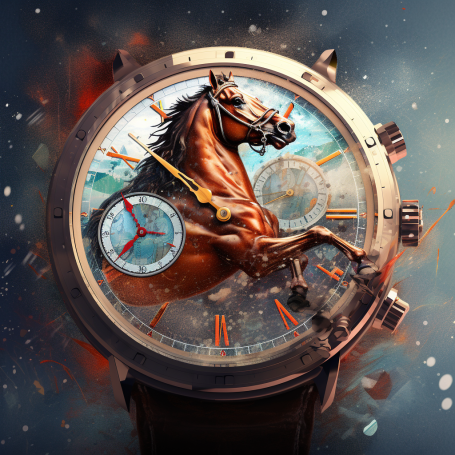To compare or determine the value of a horse, we always look for factual, quantified and quantifiable indicators.
In horse racing, for example, we look at the horse's age, recent performances and race winnings, but there's another important element to understand, and that's the stopwatch.
Table of Contents
- What is a stopwatch?
- The stopwatch launches a horse's career
- An analysis criterion
- Timing varies from track to track
- Timing varies according to race distance
- Timing varies according to terrain conditions
- Timing varies according to the horse's shoeing
- Timing varies according to discipline
- Pay attention to the chrono reference date
- The different types of stopwatch
- Conclusion
What is stopwatch ?
The stopwatch in trotting, also known as kilometer reduction, is the average time taken by a horse to cover one kilometer in a race.
Kilometre reduction is a unit of measurement used to compare horses with each other, or a horse's racing times among its most recent races.
The stopwatch to launch a horse's career
For a horse to compete in official competitions, it must pass a qualifying test, which is assessed solely on the basis of time, not performance.
A horse can qualify from the 5th month of the year in which it turns 2 up to the age of 4, and exceptionally 5. The qualifying test is run over a distance of 2000 meters.
By way of example, the qualifying time for a 2-year-old trotting horse is a maximum of 1 minute and 21 hundredths for one kilometer, i.e. a maximum of 2 minutes and 42 hundredths for the 2,000-meter qualifying event.

An analysis criterion
The stopwatch is one of the possible analysis criteria, as it can be used as a common denominator for all the starters and enables horses to be compared with each other. It is obviously not the only criterion for analysis, but it is one of a long list of possible criteria.
To use this criterion, you need to be vigilant, as several parameters need to be taken into account to get an objective view of your mileage reduction.
The stopwatch varies from track to track
To be able to compare horses fairly, you need to look at which racecourse the time taken into account was made on. Some racecourses have simpler layouts with long straights and few bends (e.g. : Caen and Meslay du Maine), while other racecourses feature difficult climbs for the horses (such as Vincennes).
That's why it's important to compare performance on similar routes.
The stopwatch varies according to race distance
Distance is also an important consideration.
A horse running a short distance (e.g. 1600 metres) will have a faster time than one running a long distance (e.g. 4100 metres).
The kilometric reduction is a unit of measurement for comparing stopwatch between them, but Usain Bolt will have a better time per kilometer than a marathon runner.
This is why a horse's best time must be adapted to the distance of the race.
The stopwatch varies according to terrain conditions
It's important to remember that a horse's performance can be affected by the condition of the ground.
If the latter is taken in midsummer on a grass field in dry weather, then it will be better than on the same field with the same distance if it is soggy.
If we compare the stopwatch of a horse on dry ground with that of another horse on sticky ground, the analysis will be biased.

The stopwatch varies according to the horse's shoeing
Shoeing can also have an impact on a horse's performance, so it's vital to pay attention.
In fact, a horse with 4 shoes on its hooves will perform less well than a horse without shoes. It's like comparing a barefoot runner with the same runner wearing boots. His average running time per kilometer won't be comparable.
The stopwatch varies according to discipline
In a previous article we detailed the different trotting disciplines.
The stopwatch different trotting disciplines
Contrary to what you might think, a horse with a jockey on its back goes slower than a horse pulling a jockey. sulky with the driver sitting on it.
In fact, each time the hooves are placed on the ground, the weight of the jockey mounted directly on the horse will have a greater impact than a sulky.
That's why, when comparing times between horses, it's important to make sure they're in the same discipline.

Pay attention to the stopwatch
If, at the time of race analysis, a stopwatch seems low compared to that of the other starters, then it is necessary to know the date on which it was carried out.
It's tricky to compare a performance from several months or even years ago with more recent news from other starters.
The weight of years diminishes a horse's performance, so be careful not to take time into account if it is more than 6 months old.
The different types of stopwatch
In the press media, in addition to tips (or on the Internet), you'll find information about the stopwatch quite easily.
However, several websites and newspapers report different categories:
These include :
- the best stopwatchAll parameters considered, we'll have to pay close attention to the race conditions on which it was taken.
- the best stopwatch on distance, which will be more refined than the one seen above
- the best stopwatch on the course, taking into account the racecourse and distance.
This last category of records is the most accurate, provided that all or most of the horses have already run on the same racecourse and at the same distance as the race to be analyzed.
Conclusion
The stopwatch or mileage reduction is an important element that can be taken into account but must be assessed with a maximum of common parameters, i.e. the race venue, distance, condition of the terrain, horse's shoeing, discipline and a stopwatch less than 6 months old.
The more common these parameters are, the more reliable the comparison will be.
However, it is highly inadvisable to use this criterion as the sole criterion for analysis, as many other parameters come into play, such as the stakes involved in the race, the horse's condition, etc...

Add a comment